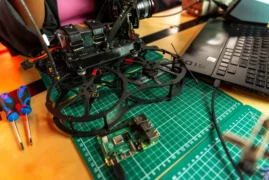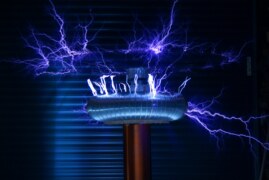If you’re interested in building your own flight controller using Arduino + MPU6050, you’ll get deep insight into:
- Sensor Fusion
- PID Control
- Motor Thrust Management
- Receiver Signal Decoding
Here’s everything you’ll need, along with the code structure, libraries, and components.
🔩 Components Required for Arduino-Based Flight Controller
| Component | Purpose |
|---|---|
| 🧠 Arduino Nano / Uno / Mega | Brain of the system |
| 📦 MPU6050 (Gyro + Accelerometer) | Senses orientation |
| 📶 RC Receiver (6CH) | Gets commands from the transmitter |
| 🌀 ESCs (4x) | Controls brushless motors |
| ⚡ Brushless Motors (4x) | Main propulsion |
| 🔋 LiPo Battery | Powers everything |
| 🔌 Power Distribution Board | Distributes power |
| 🔌 Servo Connectors / Dupont Wires | Connections between modules |
🧠 Code Overview: What Will You Program?
To make the drone fly, you need to program these core functionalities in Arduino:
✅ 1. Read Data from MPU6050
- Use I2C to get gyro + accelerometer values
- Use Kalman filter or Complementary filter for sensor fusion
✅ 2. Decode RC Inputs
- Read PWM signals (throttle, pitch, roll, yaw)
- You can use
pulseIn()or interrupts
✅ 3. PID Control
- Calculate errors between desired and current angle
- Adjust motor speed accordingly
- Use
PID_v1.hor manual PID implementation
✅ 4. Generate PWM for ESCs
- Send updated throttle values to ESCs (1000–2000 microseconds)
- Use
Servo.hor direct PWM withanalogWrite()(but better precision with Servo)
📚 Libraries Required
Install these via Arduino Library Manager or GitHub:
- MPU6050 by Jeff Rowberg
#include <Wire.h>#include <MPU6050.h> - PID_v1.h
#include <PID_v1.h> - Servo.h (for ESC control)
#include <Servo.h> - (Optional) Kalman Filter Library or Complementary Filter
Prerequisites
- Hardware:
- Arduino Nano / Uno
- MPU6050 sensor (GY-521 module)
- 4x ESC + Brushless Motors
- RC Transmitter & Receiver (6CH)
- LiPo battery (3S/4S)
- Libraries to install (via Library Manager):
MPU6050by Jeff RowbergI2Cdevlib(for MPU6050)Servo.h(built-in)PID_v1.h
🧠 Full Arduino Code for DIY Drone (Flight Controller)
cppCopyEdit#include <Wire.h>
#include <Servo.h>
#include <PID_v1.h>
#include "I2Cdev.h"
#include "MPU6050.h"
MPU6050 mpu;
Servo escFL, escFR, escBL, escBR; // ESCs for 4 motors
// PID variables
double inputRoll, outputRoll, setpointRoll = 0;
double inputPitch, outputPitch, setpointPitch = 0;
PID pidRoll(&inputRoll, &outputRoll, &setpointRoll, 1.5, 0.02, 1.0, DIRECT);
PID pidPitch(&inputPitch, &outputPitch, &setpointPitch, 1.5, 0.02, 1.0, DIRECT);
// Raw values
int16_t ax, ay, az, gx, gy, gz;
// RC Input Pins (adjust as per your receiver pins)
const int throttlePin = 2;
const int rollPin = 3;
const int pitchPin = 4;
const int yawPin = 5;
// RC Values
int throttle, rollInput, pitchInput, yawInput;
void setup() {
Serial.begin(9600);
Wire.begin();
mpu.initialize();
if (!mpu.testConnection()) {
Serial.println("MPU6050 connection failed");
while (1);
}
// Attach ESCs to PWM pins
escFL.attach(6); // Front Left
escFR.attach(9); // Front Right
escBL.attach(10); // Back Left
escBR.attach(11); // Back Right
// PID setup
pidRoll.SetMode(AUTOMATIC);
pidPitch.SetMode(AUTOMATIC);
// Calibrate MPU6050
delay(1000);
}
void loop() {
// === Read RC Inputs ===
throttle = pulseIn(throttlePin, HIGH, 25000); // 1000–2000 us
rollInput = pulseIn(rollPin, HIGH, 25000);
pitchInput = pulseIn(pitchPin, HIGH, 25000);
yawInput = pulseIn(yawPin, HIGH, 25000);
// === Read MPU6050 ===
mpu.getMotion6(&ax, &ay, &az, &gx, &gy, &gz);
// Convert raw values to angles (very basic method)
inputRoll = atan2(ay, az) * 180 / PI;
inputPitch = atan2(ax, az) * 180 / PI;
// === Map RC Inputs to Setpoints ===
setpointRoll = map(rollInput, 1000, 2000, -10, 10); // ±10° target
setpointPitch = map(pitchInput, 1000, 2000, -10, 10);
// === PID Calculations ===
pidRoll.Compute();
pidPitch.Compute();
// === Mix PID output with Throttle ===
int baseThrottle = constrain(throttle, 1000, 2000);
int motorFL = baseThrottle + outputPitch + outputRoll;
int motorFR = baseThrottle + outputPitch - outputRoll;
int motorBL = baseThrottle - outputPitch + outputRoll;
int motorBR = baseThrottle - outputPitch - outputRoll;
// Limit to ESC range
motorFL = constrain(motorFL, 1000, 2000);
motorFR = constrain(motorFR, 1000, 2000);
motorBL = constrain(motorBL, 1000, 2000);
motorBR = constrain(motorBR, 1000, 2000);
// === Write to ESCs ===
escFL.writeMicroseconds(motorFL);
escFR.writeMicroseconds(motorFR);
escBL.writeMicroseconds(motorBL);
escBR.writeMicroseconds(motorBR);
delay(10); // stabilize loop
}
🔌 RC Pin Notes
You must connect the RC receiver’s channels to Arduino pins:
- Throttle → Pin 2
- Roll (Aileron) → Pin 3
- Pitch (Elevator) → Pin 4
- Yaw (Rudder) → Pin 5
Make sure receiver is properly powered with 5V and GND.
⚠️ Important Tips
- ESC Calibration: Before flying, calibrate each ESC individually or write an auto-calibration script.
- MPU6050 Drift: This simple code doesn’t use Kalman or Complementary filters. You can improve accuracy by adding one later.
- PID Tuning: Default values work okay but not perfectly. You’ll need to tune P, I, and D values manually.
- Failsafe: This code has no failsafe. Add logic to cut motors if no signal.
🛸 Ready to Fly?
Once all 4 motors respond correctly to movement and you’ve tested motor directions:
- Install propellers (2 CW + 2 CCW)
- Power with LiPo battery
- Slowly increase throttle and test stability


Leave a comment